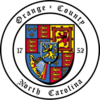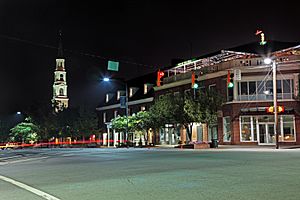Orange County, North Carolina facts for kids
Quick facts for kids
Orange County
|
|||||
|---|---|---|---|---|---|
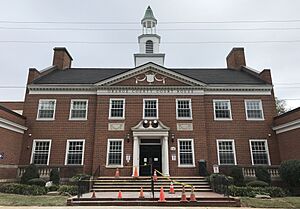
Orange County Courthouse
|
|||||
|
|||||
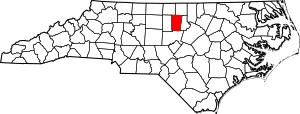
Location within the U.S. state of North Carolina
|
|||||
 North Carolina's location within the U.S. |
|||||
| Country | |||||
| State | |||||
| Founded | 1752 | ||||
| Named for | Unknown; possibly William V of Orange or William of Orange | ||||
| Seat | Hillsborough | ||||
| Largest community | Chapel Hill | ||||
| Area | |||||
| • Total | 400.96 sq mi (1,038.5 km2) | ||||
| • Land | 397.56 sq mi (1,029.7 km2) | ||||
| • Water | 3.40 sq mi (8.8 km2) 0.85% | ||||
| Population
(2020)
|
|||||
| • Total | 148,696 | ||||
| • Estimate
(2023)
|
150,626 |
||||
| • Density | 370.850/sq mi (143.1860/km2) | ||||
| Time zone | UTC−5 (Eastern) | ||||
| • Summer (DST) | UTC−4 (EDT) | ||||
| Congressional district | 4th | ||||
Orange County is a county in the Piedmont region of North Carolina. In 2020, about 148,696 people lived here. The main town, or county seat, is Hillsborough. Orange County is part of a larger area called the Research Triangle. This area includes the cities of Durham, Chapel Hill, and Raleigh. It is home to the University of North Carolina at Chapel Hill. This is the oldest state-supported university in the United States.
Contents
History of Orange County
Orange County was created in 1752. It was formed from parts of three other counties: Bladen, Granville, and Johnston. No one knows for sure how the county got its name. It might have been named after William V of Orange. His mother was Anne, daughter of King George II of Great Britain. Or it could be named after William of Orange. He became King William III of England.
Over the years, Orange County became smaller. In 1771, parts of it were used to form Guilford County and Wake County. The southern part became Chatham County. Later, in 1777, the northern half became Caswell County. In 1849, the western part became Alamance County. Finally, in 1881, part of the county joined with Wake County to form Durham County.
Some of the first people to settle here were English Quakers. They settled near the Haw and Eno rivers.
Early Days and the Revolutionary War
The town of Hillsborough was started in 1754. It was built where the Great Indian Trading Path crossed the Eno River. A surveyor named William Churton first mapped this land. The town was first called Corbin Town, then Childsburgh. In 1766, it was named Hillsborough. This was in honor of Wills Hill, the British Secretary of State for the colonies.
Hillsborough was a key place in the Piedmont region. It had a colonial court. This area saw some problems before the Revolutionary War. In the late 1760s, farmers and county officials had many disagreements. This led to the Regulator movement. This movement was also known as the War of the Regulation.
Many farmers in the Piedmont region were unhappy. They felt that the wealthy colonial officials were unfair and corrupt. Money was hard to find, so many farmers could not pay their taxes. Their property was often taken away. Some sheriffs even kept tax money for themselves.
The Regulators were mostly farmers and common people. They made up most of North Carolina's population. But a small group of wealthy people controlled the government. About 6,000 to 7,000 people in Orange County supported the Regulators.
Governor William Tryon built a very expensive new mansion. This made the Regulators even angrier. The farmers could not get their problems fixed through the government. So, they took action and closed the court in Hillsborough. They pulled officials they saw as corrupt through the streets. Governor Tryon sent his militia to stop them. The Regulators were defeated at the Battle of Alamance in May 1771. After the battle, six Regulators were hanged in Hillsborough.
Hillsborough was important during the American Revolution. It was where North Carolina's state legislature met. In 1781, British General Charles Cornwallis used Hillsborough as a military base. The United States Constitution was written in 1787. At first, delegates in Hillsborough voted against it. They were convinced to change their minds. This was partly because a Bill of Rights was promised. North Carolina later approved the Constitution in Fayetteville.
William Hooper, who signed the Declaration of Independence, was buried in Hillsborough. His original gravestone is still there. Many large plantations were in Orange County during this time.
The University of North Carolina
The North Carolina General Assembly officially started the University of North Carolina on December 11, 1789. The first stone was laid on October 12, 1793. It was built near the ruins of a chapel. This spot was chosen because it was central in the state. The university started teaching students in 1795. UNC is the oldest public university in the United States. It was the only one to give out degrees in the 1700s.
The 1800s
From 1837 to 1857, the Reverend Robert and Margaret Anna Burwell ran a school for girls. It was called the Burwell School. Wealthy families sent their daughters there for education.
When the Civil War began, Hillsborough was not eager to join the Confederacy. But many citizens still fought for the South. During the war, North Carolina Governor David Lowry Swain asked Confederate President Jefferson Davis to let some UNC students avoid fighting. Because of this, UNC was one of the few universities in the Confederacy that stayed open. However, Chapel Hill lost more people during the war than any other Southern village. The university closed for a few years after the war.
In March 1865, Confederate General Joseph E. Johnston stayed near Hillsborough. His main army was camped between Hillsborough and Greensboro.
Union General William T. Sherman was in Raleigh. He offered to meet Johnston to talk about ending the war. They met at the home of James and Nancy Bennett. This farmhouse is now called the Bennett Place. The two generals met several times in April 1865. Johnston surrendered about 89,270 Southern troops. This was the largest surrender of troops during the war. It effectively ended the Civil War.
The 1900s
Occoneechee Speedway, near Hillsborough, was one of the first NASCAR tracks. It is the only track left from NASCAR's first season in 1949. Bill France, who started NASCAR, wanted to build a larger track in Hillsborough. But local religious leaders did not want it. So, NASCAR built a big speedway in Talladega, Alabama.
Chapel Hill, Durham, and Raleigh form the "Research Triangle". This name came about in 1959. It was when Research Triangle Park was created. This park is a research area between Durham and Raleigh.
The Morehead Planetarium at UNC opened in 1949. It was one of the first planetariums in the country. It is still an important place in Chapel Hill. During the United States' space programs (like Mercury and Apollo programs), astronauts trained there.
In the 1960s, there were many student protests at UNC. Before the Civil Rights Act of 1964 was passed, people protested against racial segregation in Chapel Hill. These protests grew and led to large demonstrations.
The state legislature passed the 1963 Speaker Ban Law. This law stopped communists from speaking on state college campuses. University leaders disagreed with the law. Students also protested it. In 1968, a lawsuit was filed. A U.S. federal court ruled that the Speaker Ban Law was against free speech.
In 1968, Chapel Hill elected Howard Lee as mayor. He was the first African-American mayor elected in a mostly white town in the country. Lee was mayor from 1969 to 1975. He helped start Chapel Hill Transit, the town's bus system.
Geography and Nature
Orange County covers about 400.96 square miles. Most of this is land (397.56 square miles). A small part is water (3.40 square miles).
The Eno River flows through the county.
Chapel Hill is in the southeastern part of the county. Carrboro is also there. Hillsborough is in the center and is the county seat.
Parks and Protected Areas
Orange County has many beautiful natural areas and historic sites. These include:
- Brumley Forest Nature Preserve
- Eno River State Park (part)
- Historic Hillsborough
- Historic Occoneechee Speedway Trailhead
- Johnston Mill Nature Preserve
- North Carolina Botanical Garden
- Occoneechee Mountain State Natural Area
Major Rivers and Lakes
Important water bodies in Orange County are:
- Buffalo Creek
- Cane Creek
- Cane Creek Reservoir
- Eno River
- Haw River
- Jordan Lake
- Lake Orange
- New Hope Creek
- University Lake
Neighboring Counties
Orange County shares borders with these counties:
- Person County – to the northeast
- Durham County – to the east
- Chatham County – to the south
- Alamance County – to the west
- Caswell County – to the northwest
Main Roads
Major highways that run through Orange County include:
 I-40
I-40 I-85
I-85 US 15
US 15 US 70
US 70 US 501
US 501 NC 54
NC 54 NC 86
NC 86
Population and People
| Historical population | |||
|---|---|---|---|
| Census | Pop. | %± | |
| 1790 | 12,216 | — | |
| 1800 | 16,362 | 33.9% | |
| 1810 | 20,135 | 23.1% | |
| 1820 | 23,492 | 16.7% | |
| 1830 | 23,908 | 1.8% | |
| 1840 | 24,356 | 1.9% | |
| 1850 | 17,055 | −30.0% | |
| 1860 | 16,947 | −0.6% | |
| 1870 | 17,507 | 3.3% | |
| 1880 | 23,698 | 35.4% | |
| 1890 | 14,948 | −36.9% | |
| 1900 | 14,690 | −1.7% | |
| 1910 | 15,064 | 2.5% | |
| 1920 | 17,895 | 18.8% | |
| 1930 | 21,171 | 18.3% | |
| 1940 | 23,072 | 9.0% | |
| 1950 | 34,435 | 49.3% | |
| 1960 | 42,970 | 24.8% | |
| 1970 | 57,707 | 34.3% | |
| 1980 | 77,055 | 33.5% | |
| 1990 | 93,851 | 21.8% | |
| 2000 | 118,227 | 26.0% | |
| 2010 | 133,801 | 13.2% | |
| 2020 | 148,696 | 11.1% | |
| 2023 (est.) | 150,626 | 12.6% | |
| U.S. Decennial Census 1790–1960 1900–1990 1990–2000 2010 2020 |
|||
Who Lives Here?
In 2020, Orange County had 148,696 people. There were 55,259 households. The population is made up of different groups:
- About 64.92% are White (non-Hispanic).
- About 10.47% are Black or African American (non-Hispanic).
- About 8.48% are Asian.
- About 10.63% are Hispanic or Latino (of any race).
- Other groups make up the rest.
Education in Orange County
Orange County has two main school districts:
- Orange County Schools
- Chapel Hill-Carrboro City Schools
Media and News
Orange County is part of the Raleigh-Durham media market. This means TV and radio stations from that area serve the county. WUNC-TV, a PBS North Carolina station, is based in Chapel Hill.
Several radio stations are in the county. These include WUNC, WXYC, WCHL, and WLLQ in Chapel Hill. WQOK and WCOM-LP are in Carrboro.
The Daily Tar Heel is a student newspaper from UNC Chapel Hill. It covers news throughout Orange County.
Communities in Orange County
Cities and Towns
- Carrboro
- Chapel Hill (the largest community)
- Hillsborough (the county seat)
- Durham (mostly in Durham County)
- Mebane (mostly in Alamance County)
Other Communities
- Efland (a census-designated place)
- Many smaller, unincorporated communities like Blackwood, Caldwell, Cedar Grove, and White Cross.
Famous People from Orange County
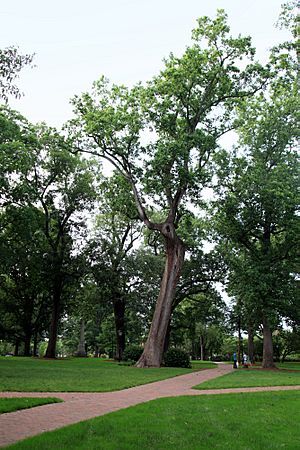
Many well-known people have lived in or are from Orange County. Here are a few:
- Alice Adams, author
- Lewis Black, comedian
- David Brinkley, newscaster
- Larry Brown, basketball coach
- Elizabeth Cotten, blues singer
- Sarah Dessen, author
- John Edwards, former Senator
- Sam Ervin, former Senator
- Ben Folds, musician
- Andy Griffith, actor
- Mia Hamm, soccer player
- Michael Jordan, basketball player
- Charles Kuralt, journalist
- Howard Lee, pioneering politician
- Mary Pope Osborne, author
- David Price, U.S. Congressman
- Dean Smith, basketball coach
- James Taylor, musician
- Lawrence Taylor, football player
- Thomas Wolfe, novelist
- James Worthy, basketball player
See also
 In Spanish: Condado de Orange (Carolina del Norte) para niños
In Spanish: Condado de Orange (Carolina del Norte) para niños



